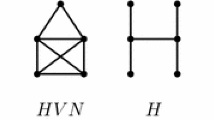Abstract
Can a non self-complementary graph have the same chromatic polynomial as its complement? The answer to this question of Akiyama and Harrary is positive and was given by J. Xu and Z. Liu. They conjectured that every such graph has the same degree sequence as its complement. In this paper we show that there are infinitely many graphs for which this conjecture does not hold. We then solve a more general variant of the Akiyama-Harary problem by showing that there exists infinitely many non self-complementary graphs having the same Tutte polynomial as their complements.


Similar content being viewed by others
References
Akiyama, J., Harary, F.: A graph and its complement with specified properties. VII. A survey, the theory and applications of graphs, pp. 1–12, Wiley, New York (1981)
Xu, J., Liu, Z.: The chromatic polynomial between graph and its complement—about Akiyama and Hararys open problem. Graphs Comb. 11(4), 337–345 (1995)
Ellis-Monaghan, J., Merino, C.: Graph polynomials and their applications. I. The Tutte polynomial, arXiv:0803.3079
McKay, B.D.: Graph6 and sparse6 graph formats. http://cs.anu.edu.au/ bdm/data/formats.html
Stein, W.A., et al.: Sage Mathematics Software (Version 5.10). The Sage Development Team (2013). http://www.sagemath.org
Acknowledgments
We are thankful to thank Sandi Klavžar for constructive remarks to Gordon Royle and Georgi Guninski for help with some computational aspects of the problem and to Nejc Trdin for kindly sharing his computational resources.
Author information
Authors and Affiliations
Corresponding author
Appendix A: Sage Programs Used in the Proofs
Appendix A: Sage Programs Used in the Proofs
In this appendix we show how to prove the claims of Lemmas 4, 5 using the open source mathematical software Sage [5]. All examples can be directly copy-pasted into Sage’s shell.
In order to prove Lemma 2, we need to verify that the presented graph has a different degree sequence than its complement but equal chromatic polynomial.

To check Lemma 5 we need to first define a function computing the subgraph description of a graph.

It is now a matter of a few lines to verify Lemma 4.

Rights and permissions
About this article
Cite this article
Azarija, J. Tutte Polynomials and a Stronger Version of the Akiyama-Harary Problem. Graphs and Combinatorics 31, 1155–1161 (2015). https://doi.org/10.1007/s00373-014-1440-2
Received:
Revised:
Published:
Issue Date:
DOI: https://doi.org/10.1007/s00373-014-1440-2




